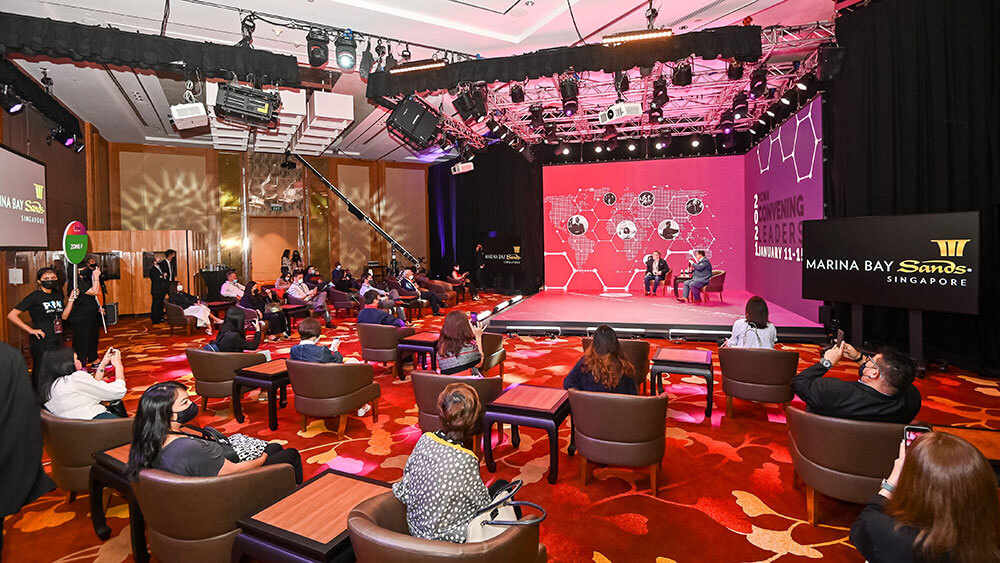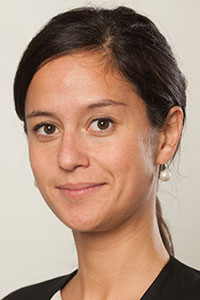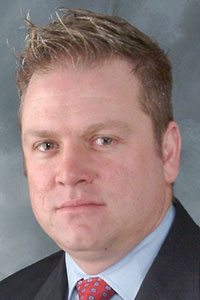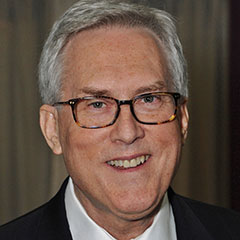What Business Events Pros Learned in 2020
Author: Bob James

Hybrid events, like the recent Convening Leaders 2021 which help a live event at the Marina Bay Sands in Singapore (above), are the next iteration of events during the pandemic. (Syafiq AB photo)
The pandemic forced massive innovation for the business events industry after an initial swirl of false starts and stops, event postponements, meeting cancellations, massive layoffs, and upended traditional business models.
“I wish our industry had been a little bit more prepared for a business disruption,” said John Toner, vice president, convention and industry collaboration, United Fresh Produce Association.

John Toner
After the coronavirus lockdown began, events-industry associations and venues scrambled to devise health protocols, hoping they would help ensure the rebound of live events. But Toner was less than enthusiastic about their effectiveness. “Health-protocol accreditations aren’t going to make any difference,” Toner said. “We can’t even follow the simple protocols we have today as a country. What makes you think people are going to follow protocols at a convention center? The decision to travel has always been a personal, risk-based one. The protocol accreditations are like LEED certifications,” he said, which may help to save the environment but aren’t so great if “my office is still cold and my feet are freezing.”
In hindsight, Toner said his own organization could have been better prepared when live events were no longer feasible had they paid closer attention to and invested more time and energy in digital tools pre-pandemic.
“We never embraced apps, but should have long ago,” he said. “A friend told me he’s a loyal follower of golf and stays in touch with the PGA several times a day through its app. So even though there are no tournaments, he’s still following golf. I wish now I had that for my show. I thought apps were just a promotional tool, but they’re really all about connecting. There are things that you know you should be doing all along, but don’t, until you’re forced to do them.”
Director of the National Restaurant Association Show, Lisa Malikow, senior vice president, event operations and programming at Winsight, shared Toner’s sentiment. “We didn’t embrace the technology tools we had before the pandemic and were caught a bit off-guard,” she said. “We wish we had moved forward more quickly on some of those things that we talked about — creating a 365 platform that would keep the show alive and a resource for people throughout the year.”
Fortunately, before the coronavirus catalyzed the collapse of live events, Malikow didn’t suffer “audience disconnect” like similar, annual live events have, thanks to the other outreach channels her organization already had in place, including webinars, trade magazines, and an industry-leading analytics and advisory arm.
We didn’t embrace the technology tools we had before the pandemic and were caught a bit off-guard.”
Lisa Malikow, senior vice president, event operations and programming at Winsight, and director of the National Restaurant Association ShowThe Rush to PivotTruth be told, the pandemic’s effects were so gargantuan, all the preparation in the world wouldn’t have assured a smoother recovery for canceled events.
“Sure, I can say we should have hooked up with a technology company before the pandemic, to be ready to go virtual ‘just in case,’” said Jerry Lewis, president, Show Management Solutions, Inc. “But it wouldn’t have made that much difference. As it turned out, before our clients could move forward with their virtual events, contracts with the hotels, the convention center, and the other contractors had to be resolved.” The announcement of the move to virtual was delayed for weeks.
“On top of the contractual issues, board approvals were needed to announce the transition. That further delayed us in going to the exhibitors to offer them the chance to convert to the virtual events, get their money back for the canceled events, or transfer their money to the following year. A lot of people worked like crazy for eight weeks to get it all done, and everything turned out reasonably well. Still, we could have used a lot more time.”
Sure, I can say we should have hooked up with a technology company before the pandemic, to be ready to go virtual ‘just in case.’ But it wouldn’t have made that much difference.”
Jerry Lewis, president, Show Management Solutions, Inc.Removing VulnerabilitiesAndrea Berry, director of membership and conferences for the aviation non-profit RTCA, discovered “how vulnerable our event sponsorships were.” After the virus forced her to convert RTCA’s live event into a series of webinars — a move that led half of her sponsors to drop out — she opened internal discussions about changing her organization’s sponsorships from events to annual, corporate ones.
“Our organization has many opportunities to provide exposure to sponsors besides events, such as our newsletter, website, and email campaigns,” Berry said. “We learned an important lesson from the pandemic: You should always be thinking about your opportunities to diversify your revenue stream. Diversity lessens your vulnerability when the unexpected happens.”

Bill McGlade
As does knowing your customer, said event technologist Bill McGlade. “My biggest ‘aha moment’ during the pandemic came when I realized that planners track engagements transactionally,” McGlade said. “They have little pieces of data here and there that don’t equate to the passion of customers, or that let them drive deeper engagement with them consistently throughout the year.” When customers “stopped being people and became data points,” McGlade said, planners lost their ability to respond effectively when the virus hit. “Data points are only good to a certain degree. Deeper engagement comes from emotional touchpoints.”
Searching for those touchpoints helped Donna Jarvis-Miller, director of membership operations and events at American Public Human Services Association, reengage members after canceling all her organization’s in-person events.
“The pandemic, or as I refer to it, the ‘unintended interruption,’ gave our association the opportunity to pause and examine the ‘why’ of our live events,” she said. “From this exercise, we created a virtual thought-leadership series on crisis management, systemic racism in human services, and leadership. It was so well-received by our members, we’ll continue the broadcasts long after the pandemic.”
COVID-19 caused Sam Lippman, president of Lippman Connects, to undertake “the hardest thing I’ve ever done professionally” — reimagine, in only weeks, a portfolio of in-person, executive-level roundtables that had taken years to build, and to digitize them.
“We had to build the plane as we were flying it,” Lippman said. Fortunately, he had decades of experience developing conference content and a team in place with fresh experience creating online businesses. “They understood the direction we were heading and could translate my objectives into our totally new format — real events in a virtual space.”
But some sponsors were skeptical. “COVID-19 was forcing all of us into something new,” Lippman said, “so we were building brand-new events. ‘But we love your real-life events,’ some sponsors said, ‘and have had no success with online ones. Please move our deposit to next year.’” Lippman was unable to convince more of his sponsors that his new online events would have the “same high level of fit and finish and strong customer service” as his in-real-life ones did. “I wish I could have done a better job of explaining how I was deconstructing my live events to make sure they would remain valuable online.”
Having a track record producing digital events before the pandemic might have helped. But it didn’t make Tim Whiting’s experience seamless when the pandemic set in. The chief revenue officer at Investments & Wealth Institute, Whiting had turned webcasting into a handsome profit center years before the pandemic compelled him to postpone his two face-to-face annual conferences and replace them with online events. But the virus also drove members to work from home, at mailing addresses Whiting for the most part didn’t have in his database. That made advance promotion of his virtual substitutes tricky.
Whiting corrected for the omission by embracing telemarketing to reach members. “We did have some home addresses, as some members have chosen that as their preference,” Whiting said, “but the majority of what we had were business addresses. It would have been beneficial to have had both.”
Whiting also said that it would have been easier to make the pivot if he had already had an agreement with a virtual event platform provider inked before the pandemic.
“We’ve been in the online space for a long time, so we had a learning management system already in place,” Whiting said. “So, when we canceled our two large events, we knew we could replace them by using it. We delivered members an asynchronous, on-demand education program that was massive, with something like 30 hours of content. It was successful, but, if hindsight’s 20/20, we should have been doing hybrid events all along. We were late to the live-streaming game and didn’t have a vendor that could deliver live-streamed events. We did fine on our own, but it would have been nice to have had one in place.”
We learned an important lesson from the pandemic: You should always be thinking about your opportunities to diversify your revenue stream. Diversity lessens your vulnerability when the unexpected happens.”
Andrea Berry, director of membership and conferences for the aviation non-profit RTCAGetting byNot every planner has been so lucky. “There are some events that do not translate well into a digital environment,” said Jacquelyn Wells, senior vice president of public relations and marketing firm mdg, which specializes in live and digital events. “Planners of those events seem to be trying just to get by until physical events can reopen.”
Those kind of events — the old-school trade shows — haven’t found their footing in the virtual space. While coronavirus clobbered conferences, conventions, and meetings in 2020, it decimated exhibitions. The $29-billion industry shrank last year by nearly 70 percent, according to AMR International’s 2020 edition of its global exhibition outlook report, Globex.
“I think we’ve all learned and can agree that so-called virtual events don’t work when the sponsors and exhibitors involved aren’t sharing content, but just sitting at booths hoping to chat,” Wells said. “Who’s to say someone doesn’t come up with some amazing software that does the trick, that delivers experiences through artificial intelligence, and is intuitive and user friendly? But for right now, the real question is: Why even try to turn a physical event into a digital one? Why not just figure out what works in digital, and focus on that, until a vaccine [is widely distributed]? Focusing on the things that work well online — and that’s typically customized content — and concentrating on your online audience — which may be quite different from your physical, in-person audience — are what will resonate.”

Mike Muldoon
The steepest challenge has been among planners who had all their eggs in one basket — the in-person event one. “We’ve been advising and educating planners for years on how to extend their live event brand year-round,” said event management expert Mike Muldoon, managing partner at Event Advisory Group, “but most say they don’t have the staff, budget, or motivation to produce anything other than their live events.”
The abrupt halt to live events sent those planners into a tailspin. “The pandemic,” Muldoon said, has been “forcing them to reinvent their events [with many] scrambling to produce something. Unfortunately, they’re throwing strategic planning out the window.”
The irony, Muldoon said, is that most planners’ organizations already possess the assets they need to grow their brands; they just haven’t harnessed them.
“For example, most planners already produce webinars throughout the year, but they’re not continuous with the educational program offered at the live event,” Muldoon said. “Most have online communities, but they don’t leverage the communities by gathering intelligence on what the industry wants to learn or see at the live event. The pandemic has provided planners an opportunity to develop new strategies and produce virtual and hybrid events with the technologies and digital assets at hand.”
Even nearly a year after the pandemic shut down in-person events for the most part, many planners still feel victimized, and remain in “a state of paralysis,” said event consultant Warwick Davies, principal, The Event Mechanic! “People are rushing to attend forums about the ‘value of live events’ because they’re paralyzed and are running around asking ‘What the hell happened?’ From there, it’s easy to begin to see yourself as a victim, cowering because of all the horrible stuff going on,” he said. “But I think now is the time to shine, to say, ‘I’m not a victim, I’m going to power through this.’”
Consumer event producer Eric Udler powered through the pandemic by hosting Super Pet Expo in August at Virginia’s Dulles Expo Center, one of the few large face-to-face events held in the U.S. in 2020. The show went off well enough, even though four of every 10 exhibitors declined to participate (Udler refunded them their booth rents) and attendance was lower than pre-show surveys of pet owners in the region predicted — around 5,000, one-third Udler’s pre-pandemic turnout.
Super Pet Expo came on the heels of Udler being named among Pet Age’s 18 2020 ICON Award winners for leadership in the pet industry, and as a result of producing the pandemic edition of an in-person event, he found himself in another limelight, if only momentarily.

Carole Boletti
“Everyone wanted to know, ‘What was it like to do a show in the pandemic?’” Udler said. Speaking about how he handled exhibitors, he said: “Not to sound arrogant, but I don’t have any regrets. Not a one. The lesson I learned is a lesson I already knew — to take the high road. I didn’t have to offer [exhibitors] their rent back, but I did, and I got their money back to them quickly. My exhibitors are all small businesses, moms and pops who can’t afford to lose any more money, and I know the goodwill is worth far more than the hit to my bottom line. It felt like a no-brainer.”
To Udler’s point, ethical business practices are key, but they don’t solve for the short-term revenue challenge. Many in the business events industry agree that the biggest challenge this year will be financial. “The priority will be how to survive 2021 with reduced revenues,” said Globex editor Carole Boletti, repeating some of the same conclusions drawn by event organizers who spoke to Convene: “AMR believes [planners] should no longer think of themselves as pure event organizers. Rather, they need to become community catalysts — facilitating business, connections, education, and advocacy.
“Events will no longer be one-off experiences,” she continued in the report. “Looking further ahead, organizers will also need to develop a post-COVID vision that addresses a radically changed market, while developing a strategy to make it happen. It will require some.thing akin to the omni-channel revolution the retail sector has undergone.
Feeling the Pinch
Warwick Davies
In 2020, planners canceled nearly all their live events after March, and those Convene interviewed handled their exhibitors and sponsors, many hit hard by the lockdown, these ways:
- Although contracts with sponsors and exhibitors protected them from loss, planners willingly overlooked those protections. They encouraged sponsors and exhibitors to roll their deposits or other payments into a future event, but readily offered full refunds when asked to do so. Two-thirds of sponsors and exhibitors rolled the money over.
- The planners who spoke to Convene handled every sponsor and exhibitor on a case-by-case basis, contacting each company via Zoom to discuss future dates. They also forgave all outstanding balances due.
- Planners felt they acted wisely in showing forbearance and granting refunds, because many of the businesses that would have participated in their live events were battling to stay afloat in 2020. “It was not the time to tighten things up,” said event consultant Warwick Davies. “Sponsors and exhibitors wanted more flexibility, not less.”




